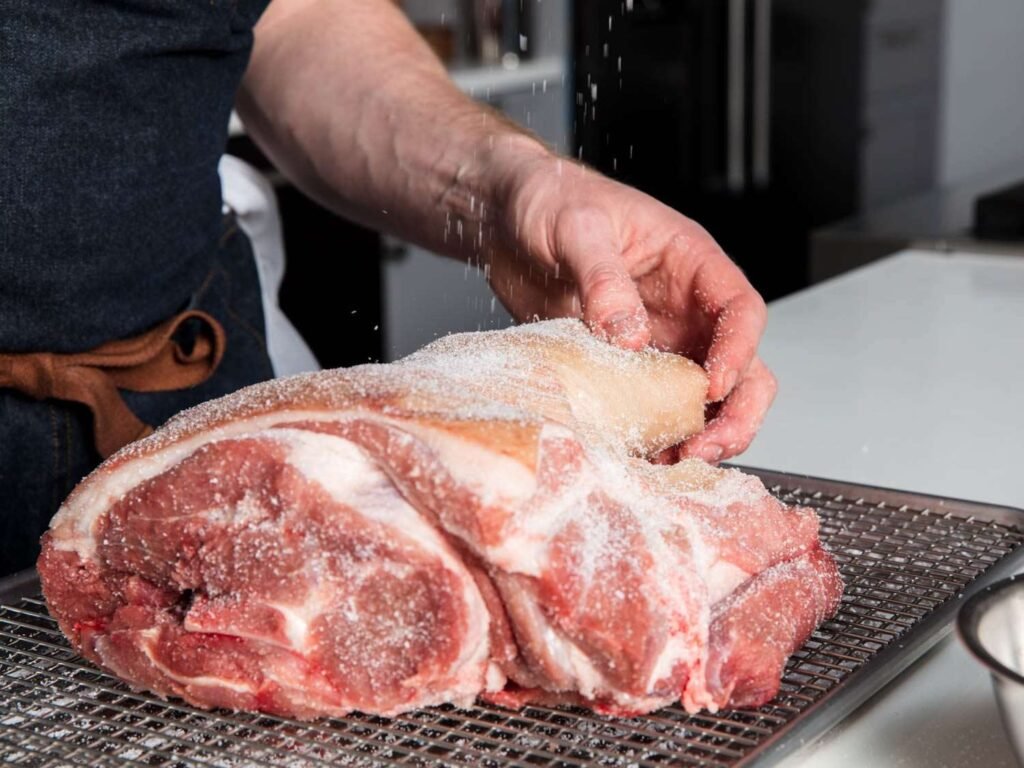Salt is perhaps the most used—and misused—ingredient in the kitchen. While its role in enhancing flavor is undeniable, its powers extend far beyond that. It can draw excess liquid from vegetables to keep them crisp and help meat retain moisture. Salt also acts as a preservative, and when used in the right quantities, keeps cured meats and pickles safe and flavorful. Learning how to harness salt’s power can make you a better cook—here’s how.
Editor’s Note
This is the second in a series of articles sharing essential tips and techniques that have changed how I, our readers, and the other Serious Eats editors cook. The first installment explored game-changing prep tips because great cooks know how to plan before the cooking begins. This series is by no means an ultimate collection of essential techniques—just some of the more important ones that separate good cooks from truly great ones.
Serious Eats / Vicky Wasik
No kitchen is complete without salt, but which salt should you reach for? Chemically, there’s no difference between kosher salt, table salt, and sea salt—all commonly used in cooking—as all are nearly 100% sodium chloride (NaCl). What sets them apart is their density (the mass per unit volume of a granular solid), which affects each salt’s texture and how quickly it dissolves. The cost of and best uses for each salt also vary.
Kosher salt: Kosher salt is ideal for seasoning food: Its large, coarse grains make it easy to pinch and sprinkle. It’s also relatively inexpensive, making it suitable for tasks in which you need a lot of salt, such as dry brining and salting pasta water. However, not all kosher salts are the same, and salt’s densities vary from brand to brand. Kosher salt is what we call for in the vast majority of our recipes at Serious Eats, and we recommend using Diamond Crystal kosher salt, as it has light, airy flakes that dissolve quickly.
Table salt: Table salt is typically less expensive than kosher salt, as it’s cost-effective to mine and process. It often contains anti-caking agents to ensure it flows freely from the box.
Sea salt: As the name suggests, sea salt is harvested from the ocean. Its texture and density can vary widely. Fine sea salts can be used to season food while cooking (though we still generally recommend seasoning with kosher salt). Flaky sea salts have a coarse, crunchy texture that delivers a sharp burst of salinity, making them ideal as finishing salts. While there are budget-friendly options, sea salt tends to be a bit more expensive than both table salt and kosher salt.
If you want to nerd out about salt, check out our comprehensive guide to different salts, including Hawaiian salt and Himalayan black salt.
Serious Eats / Amanda Suarez
One of the most important ways to make your food taste better is to season throughout the cooking process. As senior culinary editor, Leah, writes, “When done properly, you’re seasoning to maximize deliciousness and also create harmony with other flavors, such as acid, sweetness, and bitterness.” She recommends seasoning gradually, tasting after every adjustment, and being especially cautious when reducing liquids, as the evaporation process can make a dish overly salty tasting. If you oversalt a dish, try diluting the liquid or adding ingredients such as starch, acid, or cream to balance out the dish’s flavor.
While a wet brine can help meat retain moisture, it also introduces excess liquid that dilutes flavor. A dry brine, however, enhances both juiciness and flavor. Salting the meat draws moisture to the surface, where it forms a brine that is then reabsorbed, seasoning the meat from within. As the salt penetrates deeper, it dissolves and restructures muscle proteins, which then contract less and expel less moisture during cooking, resulting in tender, juicy meat.
After several hours of dry-brining in the fridge (brining time will vary depending on the cut of meat), the meat’s surface is significantly drier than before. And as former editor Sasha wrote in his guide to dry-brining, “because the moisture in the meat isn’t being squeezed out as much, thanks to the proteins dissolving and muscle fibers relaxing, the surface of the meat stays drier during cooking,” making it easier to achieve browning.
Serious Eats
You may have heard the phrase “salt your pasta water like the sea,” but that’s a myth. Our editorial director, Daniel, tested pasta water with five salinity levels ranging from 0.5% to 3.5% salt by weight to determine the ideal ratio. Seawater is about 3.5% salt by weight, which is roughly 35 grams of salt per liter of water. He found that 2% was the upper limit of what’s tolerable—nicely seasoned but not excessively so—but 1% was the ideal.
Serious Eats / Vicky Wasik
Learning how to ferment at home opens up the possibilities for tastier, more flavorful foods. Salt helps preserve cured meat, pickles, various jangs (Korean sauces), and miso—among many other foods—for months or even years. For instance, a simple lacto-fermented pickle requires nothing more than salt and a clean container to create a microbe-rich environment necessary for fermentation. Make hot sauce with chipotle, garlic, and cumin or sauerkraut, then serve it with your meals to give them a kick of heat or a nice burst of acidity. Salt not only inhibits the growth of harmful bacteria and reduces the risk of spoilage, but also flavors the finished product.

